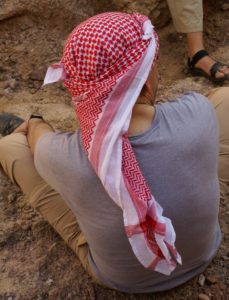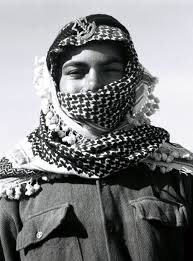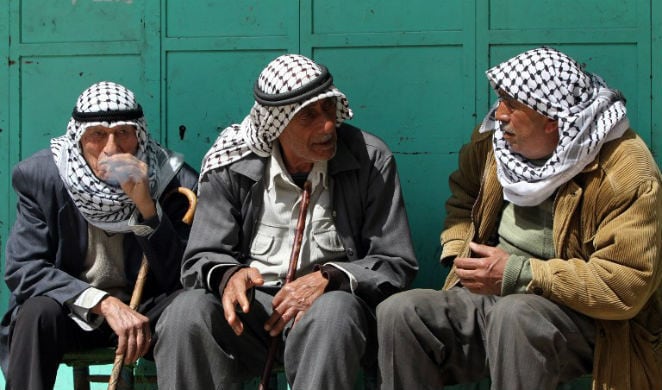The Keffiyeh, or shemagh, is a traditional headdress made from a square cotton scarf. Historically, Middle Easterners have worn it because it is practical in harsh environments. It is also worn by Arabs, Iranian nomads, especially the Kurdish people, and Mizrahi Jews.
Keffiyeh means the city of Kufa, an Iraqi town on the Euphrates River. Keffiyeh is also called as 'hattah', 'mashadah', 'cemedani', or 'chafiye'.
Keffiyeh is worn in arid regions to protect the skin against sand, dust, and sunburn. It has a woven checkerboard pattern that makes it distinctive from other cloth. It is said that the pattern originated in an ancient Mesopotamian representation of grain or fishing nets.
From the 1970s to the 1980s, the Keffiyeh became a fashion accessory in America and other parts of the world. It also became popular in Asia when people wore it with camouflage clothes.
This article will discuss when and where Keffiyeh originated and its benefits. Furthermore, we will also tackle how to tie a keffiyeh properly.
Cultural Significance
The shemagh is profoundly cultural and historical in the Middle East and has been integral to daily life for centuries. Worn by Bedouins, Arabs, Kurds, and other communities, it is more than just a practical garment; it symbolizes identity, tradition, and cultural heritage.
In many Middle Eastern countries, the shemagh is a key component of national dress. Its design and patterns vary by region and community, reflecting local customs and histories.
Beyond its cultural significance, the shemagh has also played a crucial role in military and political contexts. Military forces, including those from the Middle East, have long utilized the shemagh for its sheer functionality in harsh weather conditions.
It provides essential protection against the sun, wind, and blown dust, making it indispensable in arid environments. Additionally, the shemagh has been a powerful symbol of resistance and solidarity in various political movements, embodying the spirit of defiance and unity.
History of Keffiyeh

The Keffiyeh has a long history. Traditional head coverings like the keffiyeh and shemagh hold significant cultural importance, serving both practical and symbolic purposes. Before it became popular internationally, it was used by Arab peasants and Bedouins for centuries to protect themselves from dust, sand, sunburn, plus the coldness of the winter.
In the early 20th century, the Bedouins and the peasants traveled across cities and countries. Thus, more people have learned about Keffiyeh.
Meanwhile, in 1936, the peasants and the Palestinian villagers had an Arab Revolt against Zionist and British colonial forces. The Palestinians used the Keffiyeh as a symbol of resistance and to distinguish themselves from other people.
Ultimately, the Keffiyeh became a symbol of solidarity. It became popular in the 1960s when Yasser Arafat of the Palestinian forces wore it to fight against the Israelis.
With his strength and leadership, the Keffiyeh became a popular symbol of resistance. From the 1970s to the 1980s, several political activities and hipsters used the Keffiyeh, and ultimately, it became a trend in the West.
In 2007, the Keffiyeh reached its peak and became a fashion accessory. Since then, it has been used as an adornment and protection, especially when traveling.
Keffiyeh Variations

Palestinian keffiyehs are now made of a mixture of wool and cotton, which allows them to dry quickly and keeps the wearers' heads warm. They are folded in half like a triangle and worn across the forehead.
Often, it is held in place by an 'agal' or a rope circle. It is available in white, orange, and black colors. Some people wear the shemagh into a turban, while others wear it loosely on the back and shoulders.
In the past, people wore the Keffiyeh with the 'taqiyah cap' or wrapped it around the rim of a 'fez cap.' The red and white Keffiyeh, known as 'shemagh made,' is popular in Jordan and Saudi Arabia.
Sometimes, it has tassels on its sides that indicate status symbols. It is made of cotton or flax. The bigger the tassel, the higher the wearer's status in society. Meanwhile, the Keffiyeh in Yemen is available in red, white, and black-white patterns.
Benefits of using a Keffiyeh

A keffiyeh has many uses and benefits, especially when traveling. First, it can protect the wearer from dust, sand, and the sun. Additionally, it can be draped to provide coverage and protection for the upper arms.
You can use it to cover the face and the head, especially when traveling on motorcycles, horses, camels, etc., especially under the sun's scorching heat. Meanwhile, the Keffiyeh can warm you if you travel on cold nights, especially in the desert.
Wrap the Keffiyeh around your head and neck to survive the cold night. Second, it can be used as a cloth to wipe excessive sweat from your body. It is useful when hiking, running, or doing other extreme activities. It is small, fast-drying, and lightweight.
Thus, the sweat that it absorbs will dry fast as you travel. You can also use the Keffiyeh as a ground cloth when you sit on the ground. Third, the Keffiyeh can be used as a pillow, blanket, and eye mask, especially when sleeping.
Sometimes, you sleep outdoors without luxurious sleeping accessories. The Keffiyeh can do the magic, but it can’t give you sound sleep.
However, this cloth is better than nothing at all. Fourth, it can be used apart from a body cover.
It can be used as a hobo sack/ bag to hold a few valuables, an arm sling when you accidentally break an arm, a bandage/ tourniquet when you are bleeding, a rope to hold a few things, a weapon as self-defense by turning it in a flail with a rock or a sling, and a signal flag if you need to get someone’s attention, especially in the wild.
Furthermore, if you use your imagination, it can be used as a baby hammock, a baby wrap, and many other things.
Different Ways to Wear a Shemagh
Cowboy/ Bandana/ Cool scarf method
Try this method to look fashionable when using a keffiyeh and have good protection against the wind. The steps are the following:
-
Fold the cloth and create a triangle out of it.
-
Wrap the edge and fold it around your nose and mouth. Ensure that the other half of the triangle covers the lower half of your face.
-
Take the right and left corners on the back of your neck, cover the shoulders, and cross the ends on top of the other without making a knot.
-
Next, tie the two ends of the cloth from the back of your neck to the front of your shoulders just right. Again, the knot shouldn't be so tight that breathing is difficult, but it should also be loose enough the Keffiyeh doesn't hold.
-
Tap the remaining cloth inside your jacket to prevent the dust from getting into your nose or mouth.
-
On the other hand, if you wish to hide the remaining cloth, you can tie them in another knot beneath the lower corner of the Keffiyeh.
-
If the wind has stopped, you can blow the cover of your nose and mouth and put the Keffiyeh on your neck. Adjust the cloth if necessary.
Tactical/ Military Method
This method is used for increased protection against debris because it offers more airways coverage. It also offers protection on the head. The steps are the following:
-
Open the shemagh in a full square and fold it into two until it becomes a triangle.
-
Next, cover your forehead with the folded edge. Place the cloth in the middle of your forehead, ensuring that the right portion is almost half the length of the left one.
-
After that, place the left side of the cloth under your chin and hold it in place using your right hand.
-
Take the right side of the Keffiyeh, place it on your nose and mouth, and wrap it around your head until its end meets the end of the left side of the cloth.
-
Tie the two ends of the cloth. Once more, ensure it's not too loose so the Keffiyeh doesn't fall off and not too tight so you can breathe comfortably. Adjust the fabric as needed.
Traditional Way
The last and most common method is to wear the shemagh traditionally. Traditional head coverings like the shemagh hold cultural significance and protect against the sun, cold winds, and other elements. They protect the face, mouth, and nose against dust, fire, or other environmental elements.
Here are the steps:
-
First, fold the cloth in half and make it a triangle.
-
Next, cover your forehead with the folded edge. Place the cloth in the middle of your forehead and ensure the ends are equal on both sides.
-
Then, place the right side of the Keffiyeh underneath your chin. Take its end on your left side and left shoulder. Hold it steady for a while, using your left hand.
-
Now, place the left side of the Keffiyeh over your face and pull it to the right using your right hand. Cover your mouth and nose.
-
Knot the two ends of the Keffiyeh behind your head just right. Ensure that it’s not too loose that the Keffiyeh falls and not too tight that you can’t breathe properly. Adjust the Keffiyeh when necessary.
Advanced Tying Methods
While the traditional tying method remains popular, several advanced techniques can offer different styles and enhanced functionality. One such method is the “point three quarters” technique.
This involves folding the shemagh into a triangle and wrapping it around the head and face, leaving one corner hanging down. This method provides excellent sun protection and is particularly effective in harsh weather conditions, shielding the wearer from the elements.
Another advanced tying method is the “left hand” technique. This approach is tailored for those who are left-handed or prefer to tie with their left hand.
It involves wrapping the shemagh around the head and face, starting with the left hand and securing it. This method ensures a snug fit and can be adjusted for comfort and protection, making it a versatile option for various situations.
By exploring these advanced tying methods, you can personalize your shemagh-wearing experience and ensure style and practicality in any environment.
Tips on how to buy a Shemagh
Now that we know how to tie a shemagh, it’s time to know what to look for when buying one. Buying one can sometimes be overwhelming, especially if it’s your first time.
Thus, these are some of the features that you should check out in choosing a shemagh in the market:
Color
A light-colored shemagh is recommended for warm, sunny weather. Choose darker colors, like black or red, if you plan to wear it in cold, cloudy conditions. Exercise caution when wearing a shemagh while visiting Arab countries or if you intend to use it as a political statement.
Comfort
Check if the product is comfortable in your skin and other body parts. You will be wrapping the Keffiyeh around your neck, head, and face; thus, it mustn't irritate you. Make sure not to buy a product because it only looks good but doesn't feel good. Its comfort must be your top priority.
Durability
An item that can easily be damaged is a bad investment for a keffiyeh. Thus, make sure that the product you're buying is durable. Check the craftsmanship of the Keffiyeh, such as its seams. Sometimes, investing money in a good product manufactured by a trusted company can save you from hassle. You can also confidently use the product no matter where you go.
Material

When buying a shemagh or Keffiyeh, always choose the best material: cotton. Cotton shemaghs are sturdy and lightweight. They are also helpful if you need an additional urgent bag when traveling. Cotton is resistant and can be used in many ways.
Cotton keffiyeh can dry immediately, especially when used as a towel to wipe excess sweat and moisture from rain or snow during summer days. Lastly, it can keep your body's temperature constant and protect you from heat or cold.
Weight
Keffiyeh comes in various kinds according to its weight. If you wish to use a keffiyeh as a blanket to protect your body against the cold weather, then a heavy product is best for you. However, a lighter product is recommended if you use a keffiyeh to protect yourself from the sun or use one for fashion.
Size
Size is also an important factor to consider when buying a keffiyeh. Choose a larger option if you frequently go camping, hiking, or other outdoor activities. On the other hand, a smaller size can be useful for fashion or other purposes.
Conclusion
In summary, the keffiyeh is a widely used product today. It embodies the beautiful, honed culture of our Arabian brothers. This cloth has been used to symbolize the unity and political ideology of many organizations worldwide.
Furthermore, it is a useful adornment that protects the face and other body parts from weather conditions. For many years, it has helped people survive outdoors and will continue to be used by many people.






















































